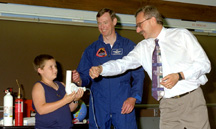 Purdue News
Purdue News
 Purdue News
Purdue News
February 14, 1997

|
The directors -- from each of the seven universities involved in the consortium -- will hold their annual meeting at Purdue on Wednesday, Feb. 26, from 10 a.m. to 3 p.m. in Room 333, Grissom Hall.
The Indiana Space Grant Consortium is one of 52 such groups nationwide funded by the National Aeronautics and Space Administration. The national program was established in 1989, and Indiana's in 1991, to promote programs related to aeronautics and space science in three areas: research, education and public service.
"Our group is involved in many activities around the state," said consortium director Dominick Andrisani, associate professor of aeronautics and astronautics at Purdue. "For example, universities sponsor teacher workshops, public lectures and demonstrations, fund scholarships and research projects, develop curriculum, and provide expertise and exhibits to museums.
"Our objectives include recruiting and training citizens for careers in aerospace, providing industry with top-quality graduates, and supporting science and mathematics education in general."
In addition to Purdue's West Lafayette campus, consortium members are: Purdue Calumet, the University of Notre Dame, and Indiana, Ball State, Taylor and Valparaiso universities. Ball State, Taylor and Valparaiso joined the consortium in the past year. Andrisani said that in the coming year, the consortium plans to add three more academic institutions from the central and southern half of the state.
At the annual meeting, students and faculty will describe consortium activities from the past year and plan for the coming year.
The Indiana Space Grant Consortium receives about $170,000 from NASA each year, which is shared by all seven universities.
In the past year, the consortium also established a distinguished lecture series. The first lecture, held last month at Indiana University, featured Gina Kolata, a science reporter with the New York Times. The second lecture will be at Ball State.
Some consortium-sponsored programs are:
Source: Dominick Andrisani, (765) 494-5135; e-mail, andrisani@ecn.purdue.edu
Writer: Amanda Siegfried, (765) 494-4709; e-mail, amanda_siegfried@purdue.edu
Purdue News Service: (765) 494-2096; e-mail, purduenews@purdue.edu
NOTE TO JOURNALISTS: Journalists are welcome to attend the annual meeting of the directors of the Indiana Space Grant Consortium from 10 a.m. to 3 p.m. Wednesday, Feb. 26, in Room 333 of Grissom Hall at Purdue.
Photo caption
Dominick Andrisani, right, and former NASA astronaut Mark Brown get the audience involved
in a public presentation called "A Taste of Aerospace." Andrisani, associate professor
of aeronautics and astronautics at Purdue, travels around Indiana giving demonstrations of the principles of aerospace. (Photo by Mary Jo Corso, Purdue Center for
Instructional Services.)
Color photo, electronic transmission, and Web and ftp download available. Photo ID:
Andrisani/Space
Download here